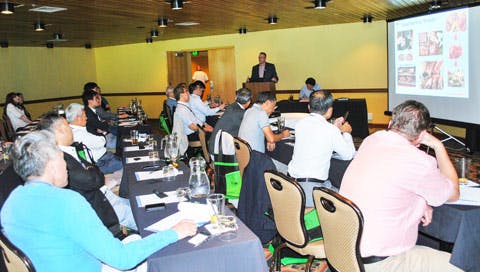Japan Foodservice Association in Denver for Update on U.S. Beef, Pork
More than 20 executives representing leading Japanese foodservice companies and restaurants traveled to Denver this week for a USMEF briefing on U.S. red meat, updates on market and economic conditions and plans to gain a greater share in Japan for U.S. beef and pork.

Travis Arp, USMEF director of market access and export services, discusses red meat quality and utilization trends at a meeting with members of the Japan Foodservice Association
The meeting, hosted by USMEF and Potatoes USA, was part of an expansive tour of the U.S. food industry – from dairy to lettuce to strawberries – by the Japan Foodservice Association.
In Denver, discussions focused strictly on red meat and potatoes.
“USMEF works with more than 300 companies in Japan, and some of those companies are represented here in this room,” USMEF President and CEO Philip Seng said as he opened the meeting. “The relationship over the years between USMEF and the Japan Foodservice Association – which represents over $300 billion in annual business – has been very positive, as have our relationships with the member companies. As for our approach to doing business in Japan, we feel very strongly about working closely with individual companies to support and complement their business plans.”
Seng provided the group with an overview of USMEF activities in Japan. He noted that USMEF’s efforts include the continued building of U.S. red meat’s image and brand, expanding the number of cuts and concepts being promoted and encouraging more chefs and foodservice professionals to include U.S. beef and pork on restaurant menus. He also discussed new programs such as the urban barbecue promotion, which is designed to highlight the use of sub-primal cuts while dispelling common beliefs about the difficulty of preparing these cuts.
Travis Arp, USMEF director of market access and export services, explained how marbling, feed, genetics and age affect the overall quality of beef and pork. Arp also outlined the U.S. red meat grading system and the advantages of grain-fed versus grass-fed beef.
When it comes to meat quality, Arp said, consumers can tell the difference.
“Research has shown over and over that the odds of a positive eating experience jump significantly when high-quality meat is used,” he added.

Members of the Japan Foodservice Association sample U.S. beef prime rib and U.S. pork maple rubbed ham at a USMEF reception
Jessica Strutzel, USMEF trade analyst, followed with a market report on U.S. beef and pork. She noted that growth in production has had a downward effect on prices – and that beef and pork production are expected to continue to expand through 2017.
Strutzel pointed out that Japan is currently the top volume market for U.S. beef, and that U.S. beef and variety meat exports to Japan are forecast to grow by 11 percent in 2016. Japan is currently the No. 2 volume market for U.S. pork.
As for the future, “We are optimistic about the potential for growth in Japan’s meat consumption,” said Strutzel, who highlighted the growth of foodservice chains in Japan and the Asia Pacific region.
Following the briefing, USMEF hosted a reception for participants, serving U.S. beef roasted prime rib and U.S. pork bourbon maple rubbed ham.
The Japan Foodservice Association is the nation’s largest foodservice industry organization, with more than 800 companies and 65,000 outlets represented in its membership. On this visit to the U.S., the group began in California with a look at the lettuce, strawberry and dairy industries, before touring the JBS plant in Greeley, Colorado, and the Tyson plan in Perry, Iowa, after stopping in Denver.
“The people here with us are executives from some of Japan’s biggest foodservice companies, and some of them are on our board of directors,” said Hisao Fukuda, COO and secretary general of the Japan Foodservice Association. “We are basically here in the U.S. to evaluate different parts of food sourcing and to learn as much as we can about each segment. Beef and pork are a huge part of the food culture back in Japan, so the information provided by USMEF has been valuable for our members.”
